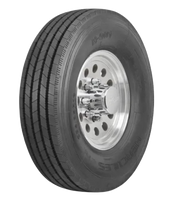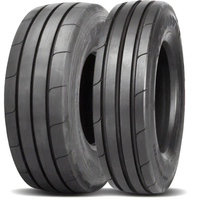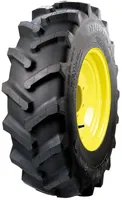Agricultural Tire Size
Agricultural tires play a crucial role in the farming industry, providing the necessary traction and stability for various vehicles and equipment. Choosing the right set of tires for the job doesn't have to be hard. However, it is the key to maximizing productivity and yield.
First of all, agricultural tires are developed to minimize soil impact, keeping the crops or the turf protected from compaction. Despite their aggressive looks, farm tires feature high-flotation builds and designs that apply a gentle touch on the ground, thus preventing soil damage.
The Main Categories
There are four main categories of agricultural tires, each designed for specific demands and applications:
The R-1 tires are the most common ones, suitable for tractors from 30 up to 150 HP. They usually fit on 2-wheel drive tractors, combine harvesters, sprayers, and other implements carrying heavy loads. Manufacturers develop these tires for general farm use, delivering the best traction and performance in average soil conditions.
The R-2 tires use a specific tread pattern designed for extremely muddy soil conditions such as paddy fields, rice fields, and other heavily irrigated soils. The tread is at least two times deeper than that of R-1 tires, meaning that it doesn't perform well on the road because the lugs can bend easily and lead to irregular tread wear.
The I-1 tires are crafted for field and road transport operations as well as soil tillage jobs that involve implements and trailers. These tires have a special tread pattern that optimizes fuel efficiency and stability, safely following the path of the towing vehicle.
The I-3 tires feature a traction tread pattern and are mainly found on heavy load implements such as manure carriers and tankers. These tires provide a great balance of flotation and traction without sacrificing load capacity. The shallow tread depth lowers the rolling resistance for maximum fuel economy.
Pressure, Load ratings, and Technologies
Depending on size and application, tires will require various PSI levels to maximize their performance. Some tractor tires are developed with special technologies such as IF (Increased Flexion) and VF (Very High Flexion). The secret is in the highly technical sidewalls that use an optimized build to carry heavier loads at the same load pressure. For example, IF tires can support 20% more load pressure and VF tires handle 40% more load stress than standard tires at the same PSI.
It is very important to choose tires with a high enough load rating for your type of application to ensure safe performance. The load rating shows the highest load pressure and weight that the tire can handle without risking blowouts or deformation. In addition, a tire's maximum pressure must not be higher than the recommended one because it can decrease its fuel efficiency and overall performance.
The construction of Farm Tires
Primarily, agricultural tires come in tube type and tubeless options. Both builds have their pros and cons, so choose them accordingly. Nowadays, more tires are tubeless because they offer increased flotation and better resistance to punctures. However, they are harder to install and repair. On the other hand, tubed tires are more prone to flats after sustaining damage, but they are easier to repair.
Farm tires can also be classified according to their structure type: Bias and Radial. The main difference between them is the ply placement into the tire.
Radial tires feature more flexible sidewalls that optimize pressure circulation. This avoids pressure and heat buildup, leading to longer tread life and lower fuel usage. So, if you use the tractor mainly for fieldwork, then radial tires are the better choice.
Bias or Diagonal tires avoid sidewall flexing, protecting the casing from external damage and raising overall durability. This build makes the tire more suitable for hillside and harder ground operations by providing additional grip. Adding to this, their sturdy structure can carry heavier loads. Due to their stronger construction, we do not recommend using bias tires on soft fields, as this may result in a high risk of slipping.
Tread Designs
Lastly, agricultural tires are available in two main tread designs: Lugs and Ribs. Choosing the right pattern for the job is key to maximizing productivity and efficiency.
A directional lug pattern, usually with overlap at the center, provides an increased tread life due to its high depth. The elevated blocks resist chip and cut damage while offering excellent traction on hard and soft terrains. They create plenty of biting edges that raise grip and responsiveness, smoothly propelling the tractor forward at the operator's command. This design is mostly found on rear position tires, as it is more suitable for traction. However, this doesn't mean that front position tires don't sometimes use it.
On the other hand, a raised center rib pattern focuses on improving the tire's surface contact. Depending on the application, it features a multi rib design or a single rib one, providing superior steering and stability. This design suits the front axle of tractors and the free rolling axle of implements due to its superb controllability. Moreover, tires with a ribbed tread pattern are more suitable for slippery terrain jobs.
The most popular Farm Tire brands
Finally, agricultural tires come in various sizes and designs to meet the demands of numerous farmers around the world. If you are looking to upgrade your farming game, then trusted brands such as Goodyear, Michelin, Titan, Firestone, BKT, and Mitas are your best options. Of course, there are many more farm tire manufacturers across the globe, however, we promise that you will never go wrong when choosing these names on the wheels of your tractor.
Agricultural tires play a crucial role in the farming industry, providing the necessary traction and stability for various vehicles and equipment. Choosing the right set of tires for the job doesn't have to be hard. However, it is the key to maximizing productivity and yield.
First of all, agricultural tires are developed to minimize soil impact, keeping the crops or the turf protected from compaction. Despite their aggressive looks, farm tires feature high-flotation builds and designs that apply a gentle touch on the ground, thus preventing soil damage.
The Main Categories
There are four main categories of agricultural tires, each designed for specific demands and applications:
The R-1 tires are the most common ones, suitable for tractors from 30 up to 150 HP. They usually fit on 2-wheel drive tractors, combine harvesters, sprayers, and other implements carrying heavy loads. Manufacturers develop these tires for general farm use, delivering the best traction and performance in average soil conditions.
The R-2 tires use a specific tread pattern designed for extremely muddy soil conditions such as paddy fields, rice fields, and other heavily irrigated soils. The tread is at least two times deeper than that of R-1 tires, meaning that it doesn't perform well on the road because the lugs can bend easily and lead to irregular tread wear.
The I-1 tires are crafted for field and road transport operations as well as soil tillage jobs that involve implements and trailers. These tires have a special tread pattern that optimizes fuel efficiency and stability, safely following the path of the towing vehicle.
The I-3 tires feature a traction tread pattern and are mainly found on heavy load implements such as manure carriers and tankers. These tires provide a great balance of flotation and traction without sacrificing load capacity. The shallow tread depth lowers the rolling resistance for maximum fuel economy.
Pressure, Load ratings, and Technologies
Depending on size and application, tires will require various PSI levels to maximize their performance. Some tractor tires are developed with special technologies such as IF (Increased Flexion) and VF (Very High Flexion). The secret is in the highly technical sidewalls that use an optimized build to carry heavier loads at the same load pressure. For example, IF tires can support 20% more load pressure and VF tires handle 40% more load stress than standard tires at the same PSI.
It is very important to choose tires with a high enough load rating for your type of application to ensure safe performance. The load rating shows the highest load pressure and weight that the tire can handle without risking blowouts or deformation. In addition, a tire's maximum pressure must not be higher than the recommended one because it can decrease its fuel efficiency and overall performance.
The construction of Farm Tires
Primarily, agricultural tires come in tube type and tubeless options. Both builds have their pros and cons, so choose them accordingly. Nowadays, more tires are tubeless because they offer increased flotation and better resistance to punctures. However, they are harder to install and repair. On the other hand, tubed tires are more prone to flats after sustaining damage, but they are easier to repair.
Farm tires can also be classified according to their structure type: Bias and Radial. The main difference between them is the ply placement into the tire.
Radial tires feature more flexible sidewalls that optimize pressure circulation. This avoids pressure and heat buildup, leading to longer tread life and lower fuel usage. So, if you use the tractor mainly for fieldwork, then radial tires are the better choice.
Bias or Diagonal tires avoid sidewall flexing, protecting the casing from external damage and raising overall durability. This build makes the tire more suitable for hillside and harder ground operations by providing additional grip. Adding to this, their sturdy structure can carry heavier loads. Due to their stronger construction, we do not recommend using bias tires on soft fields, as this may result in a high risk of slipping.
Tread Designs
Lastly, agricultural tires are available in two main tread designs: Lugs and Ribs. Choosing the right pattern for the job is key to maximizing productivity and efficiency.
A directional lug pattern, usually with overlap at the center, provides an increased tread life due to its high depth. The elevated blocks resist chip and cut damage while offering excellent traction on hard and soft terrains. They create plenty of biting edges that raise grip and responsiveness, smoothly propelling the tractor forward at the operator's command. This design is mostly found on rear position tires, as it is more suitable for traction. However, this doesn't mean that front position tires don't sometimes use it.
On the other hand, a raised center rib pattern focuses on improving the tire's surface contact. Depending on the application, it features a multi rib design or a single rib one, providing superior steering and stability. This design suits the front axle of tractors and the free rolling axle of implements due to its superb controllability. Moreover, tires with a ribbed tread pattern are more suitable for slippery terrain jobs.
The most popular Farm Tire brands
Finally, agricultural tires come in various sizes and designs to meet the demands of numerous farmers around the world. If you are looking to upgrade your farming game, then trusted brands such as Goodyear, Michelin, Titan, Firestone, BKT, and Mitas are your best options. Of course, there are many more farm tire manufacturers across the globe, however, we promise that you will never go wrong when choosing these names on the wheels of your tractor.
Need live support?
- Mon - Fri: 8am - 7pm ET
- Sat: 9am - 5pm ET
- Sun: Closed










